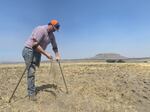
In a 2021 photo, Ben DuVal, president of the Klamath Water Users Association, sifts the soil in one of his dry fields near his Tulelake home that was first owned by his grandfather.
Holly Dillemuth / JPR News
After last year’s drought that saw protests and threats of breaking into federal water management facilities, the implications of the recent Klamath Irrigation District (KID) vote are unclear, but support from irrigators was widespread last Tuesday.
Out of 377 votes, 319 KID members voted ‘yes’ to the ballot question: “Pursuant to both our federal contract obligations and state water rights, do you want the district to attempt to deliver you water knowing it will likely complicate federal drought funding?”
“The results of the election really let the directors know that the sentiments of the patrons of the district would prefer water over federal funding,” says Gene Souza, executive director and district manager of the Klamath Irrigation District.
The U.S. Bureau of Reclamation has not yet announced how much water will be delivered to farmers this year. 2021 was the first year the federally managed Klamath Project provided no water to local irrigators in the heavily farmed Klamath Basin, which spans the Oregon-California border.
But with much of Klamath and Siskiyou counties in the highest categories of drought, 2022 could be equally dry. Oregon’s Klamath County is experiencing the fourth driest year to date in the past 128 years, according to the National Integrated Drought Information System. On the California side, Siskiyou County is experiencing the second driest year in that same time period.
To support farmers last year, federal agencies sent tens of millions of dollars in drought relief to communities in the Basin, including $15 million from the USDA and $20 million from the Bureau of Reclamation. But Souza says that drought funding makes up a fraction of what would be generated by farmers and which would, in turn, stimulate the local economy.
“That doesn’t create jobs, that doesn’t create a sense of pride in getting something accomplished, that doesn’t help spread that money,” Souza says.
Basin farmers are restricted from using water stored in Upper Klamath Lake which is maintained to protect several species of endangered sucker fish that are culturally important to the Klamath Tribes. Water is also sent down the Klamath River, for threatened Coho salmon that are significant culturally and as a food source for California’s Yurok, Karuk and Hoopa tribes.
But some irrigators like Klamath Basin farmer Ry Kliewer argue there are conflicts between state and federal water laws that need to be resolved.
“I think that a lot of people here are sick and tired of being told by the federal government ‘you have no water, you have no water, we can tell you what to do and you’re gonna like it,’” Kliewer says.
Without enough water for endangered species, Native American tribal water rights, nearby national wildlife refuges, and agriculture, it’s unclear whether the KID vote could help or hurt farmers and ranchers in the Basin. During a June, 2021 public meeting held in Klamath Falls, Republican Rep. Cliff Bentz of Oregon warned residents against taking matters into their own hands to try to get water from federal facilities for two reasons. “They could go to jail and two, it’s going to hurt my ability to get money for the Basin,” Bentz said.